


Copper(II) thiocyanate complex chemistry
Copper(II) ions, when combined with thiocyanate ions, show a remarkably rich and complicated chemistry. It can be called complex chemistry, with multiple meanings associated with the word 'complex'.
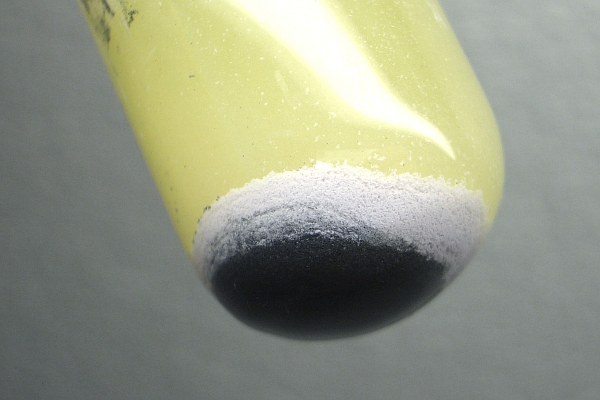
When solutions with copper(II) ions and thiocyanate ions are mixed with each other, then the behavior of such mixes strongly depends on the concentration of the reactants and the relative amounts of the reactants used.
![]()
![]() Required
chemicals:
Required
chemicals:
-
copper sulfate pentahydrate
-
potassium thiocyanate (the sodium and ammonium salts work equally well)
-
sodium sulfite
-
nitric acid (50% .. 65%)
![]() Required
equipment:
Required
equipment:
-
test tubes
![]() Safety:
Safety:
- None of the chemicals is particularly toxic or corrosive. Use due care and avoid prolonged contact with skin and contact with eyes.
![]() Disposal:
Disposal:
- Copper(II), although only moderately toxic for humans, is very toxic for lower aquatic life forms. Do not flush the waste down the drain and bring it to a proper waste processing facility.
![]()
Formation of isothiocyanato complex
![]() Take a test tube with a dilute solution of potassium
thiocyanate and add a few big drops of concentrated solution of copper sulfate,
while the thiocyanate is present in excess amount. When this is done, then a
nice green solution is obtained, which however, slowly turns turbid. The left
picture shows the result immediately after adding the few drops of copper(II)
solutions, the right picture shows the result after approximately 1 minute.
Take a test tube with a dilute solution of potassium
thiocyanate and add a few big drops of concentrated solution of copper sulfate,
while the thiocyanate is present in excess amount. When this is done, then a
nice green solution is obtained, which however, slowly turns turbid. The left
picture shows the result immediately after adding the few drops of copper(II)
solutions, the right picture shows the result after approximately 1 minute.
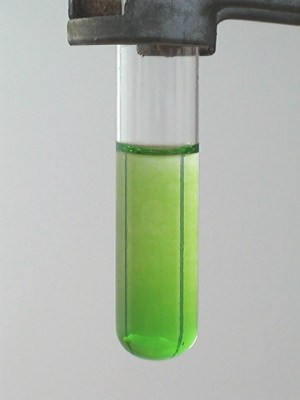
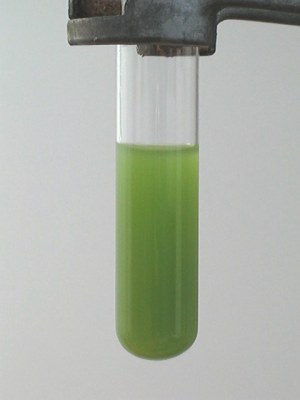
![]() Transfer
the turbid green liquid to a wide test tube and set it aside for a somewhat
longer time. After an hour or so, two precipitates have settled. A black
precipitate has settled at the bottom, a white precipitate has settled above the
black precipitate and a very fine yellow suspension is visible in the liquid,
which has not yet settled and which takes a much longer time to settle. The two
pictures below show the precipitates.
Transfer
the turbid green liquid to a wide test tube and set it aside for a somewhat
longer time. After an hour or so, two precipitates have settled. A black
precipitate has settled at the bottom, a white precipitate has settled above the
black precipitate and a very fine yellow suspension is visible in the liquid,
which has not yet settled and which takes a much longer time to settle. The two
pictures below show the precipitates.
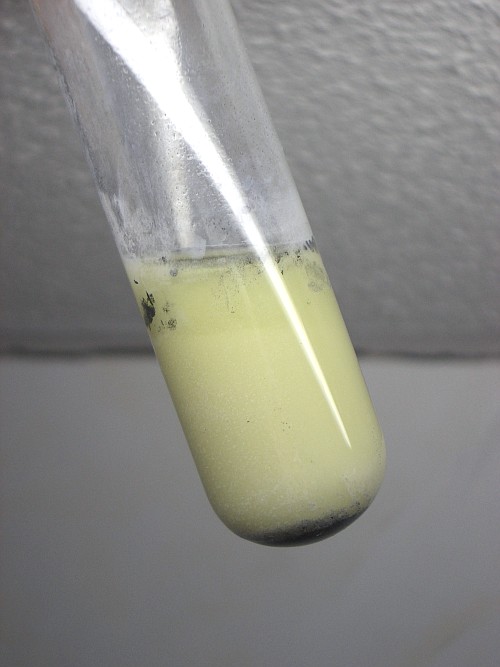

![]() Shake
the test tube with the two layers of precipitate and let settle again. This
again results in fastest settling of the dark compound, but now the dark
compound also is mixed with the white material. The liquid itself remains turbid
and light yellow. The picture below shows the test tube after it has been shaken
and the precipitate has allowed to settle again.
Shake
the test tube with the two layers of precipitate and let settle again. This
again results in fastest settling of the dark compound, but now the dark
compound also is mixed with the white material. The liquid itself remains turbid
and light yellow. The picture below shows the test tube after it has been shaken
and the precipitate has allowed to settle again.
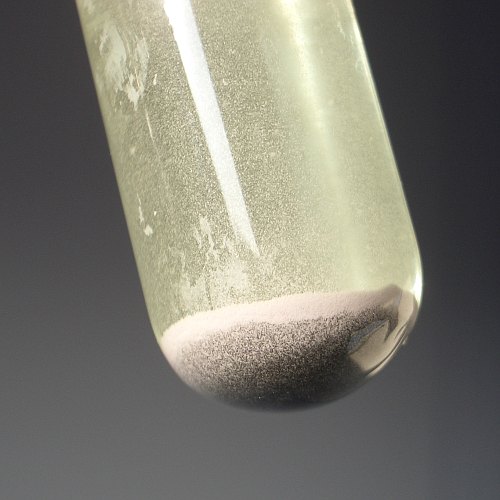
A small video is available of the making of the green complex and the slow change to turbidity. Download size is approximately 3 MByte.
![]()
Formation of black copper(II) isothiocyanate
![]() Totally
different results are obtained when a concentrated solution of copper(II)
sulfate is added to a fairly concentrated solution of potassium thiocyanate,
with copper(II) ion in excess. When this is done, a black precipitate is formed
at once, which remains black on standing.
Totally
different results are obtained when a concentrated solution of copper(II)
sulfate is added to a fairly concentrated solution of potassium thiocyanate,
with copper(II) ion in excess. When this is done, a black precipitate is formed
at once, which remains black on standing.
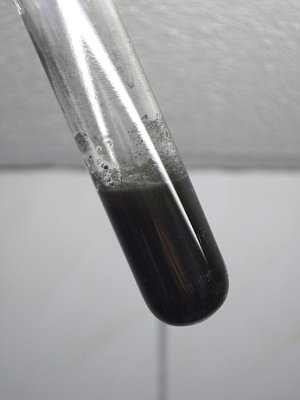
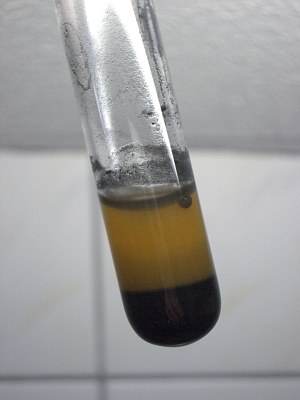
After some time of standing, the black precipitate has settled and a turbid brown liquid remains. After much longer standing, a very thin lighter layer of precipitate covers the black precipitate.
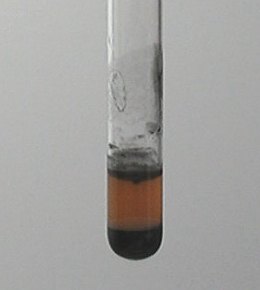
This reaction also can be viewed in a video (download size 415 KByte).
![]()
Influence of presence of sulfite ions
When sulfite ions are added to the mix, then things change drastically. Sulfite acts as a mild reductor and in this case, it immediately and quickly reduces any complex or precipitate with copper(II) in it to a copper(I) compound.
![]() Prepare
a solution of potassium thiocyanate to which a similar amount of sodium sulfite
is added. Of both chemicals add a small spatula full of solid to a few ml of
water and swirl to dissolve. To this thiocyanate/sulfite mix add a few drops of
concentrated solution of copper sulfate. When this is done, a grey precipitate
is formed, which immediately turns white.
Prepare
a solution of potassium thiocyanate to which a similar amount of sodium sulfite
is added. Of both chemicals add a small spatula full of solid to a few ml of
water and swirl to dissolve. To this thiocyanate/sulfite mix add a few drops of
concentrated solution of copper sulfate. When this is done, a grey precipitate
is formed, which immediately turns white.
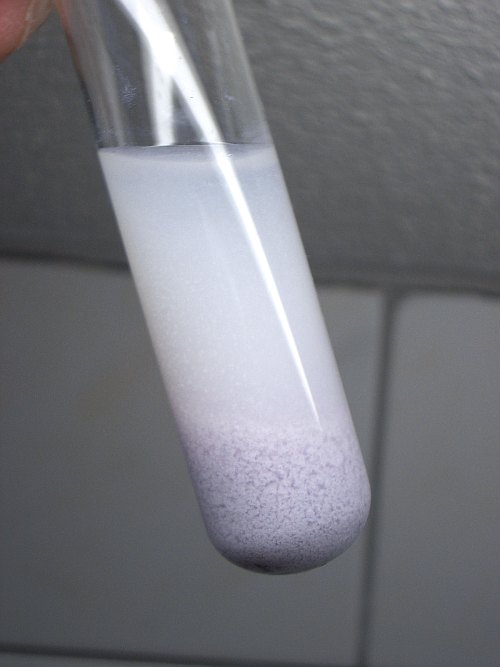
A video shows the formation of the grey precipitate and the immediate change to white color (download size is approximately 1 MByte).
![]() When the
experiment is repeated with a similar concentration of thiocyanate (1 small
spatula full of potassium thiocyanate) but the amount of sodium sulfite is
reduced to a tiny pinch (just a few mm³ of crystal powder), then a beautiful
effect is obtained with a precipitate flashing through different colors. The
final result is a white precipitate with tiny black specks in it.
When the
experiment is repeated with a similar concentration of thiocyanate (1 small
spatula full of potassium thiocyanate) but the amount of sodium sulfite is
reduced to a tiny pinch (just a few mm³ of crystal powder), then a beautiful
effect is obtained with a precipitate flashing through different colors. The
final result is a white precipitate with tiny black specks in it.
The video, showing the formation of precipitate after adding a few drops of concentrated solution of copper sulfate, is well worth the download time (download size is approximately 2.5 MByte).
![]() Finally,
the effect of sulfite on an existing black precipitate of copper(II)
isothiocyanate is investigated by adding an excess amount of a solution of
sodium sulfite to a dark precipitate of copper(II) isothiocyanate.
Finally,
the effect of sulfite on an existing black precipitate of copper(II)
isothiocyanate is investigated by adding an excess amount of a solution of
sodium sulfite to a dark precipitate of copper(II) isothiocyanate.
When this is done, then quickly the precipitate changes color from black to white. This is demonstrated in a video (download size is 1.3 MByte).
![]()
Oxidation of copper(I) thiocyanate
Copper(I) thiocyanate is a fairly strong reductor, which can be oxidized easily (e.g. a mix of CuSCN and KClO3 deflagrates when finely powdered). In this experiment, the copper(I) thiocyanate, prepared in the experiment above, is rinsed with water and almost all water is decanted from this, resulting in a test tube, filled with some wet CuSCN. On top of this liquid with the suspended precipitate, carefully some concentrated nitric acid was poured.
This results in oxidation of the solid, the acid 'eating' through the solid. It is remarkable to see that the upper layer of the precipitate turns black before it is completely oxidized and goes in solution. The nitric acid first causes formation of black copper(II) isothiocyanate, but quickly the thiocyanate is completely destroyed by the acid. The following pictures show how the acid eats through the precipitate.
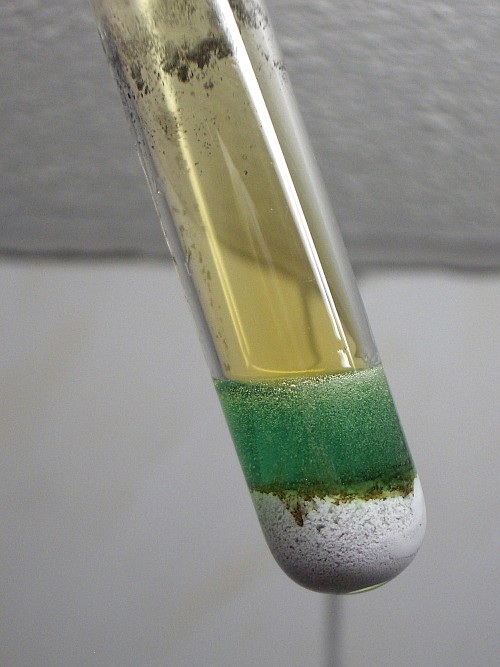
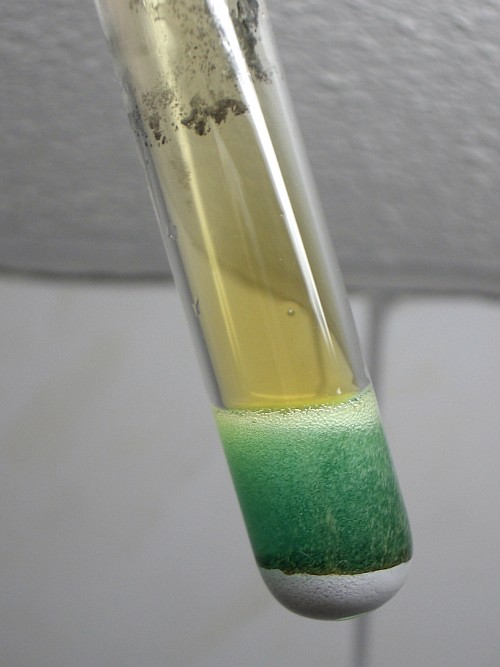
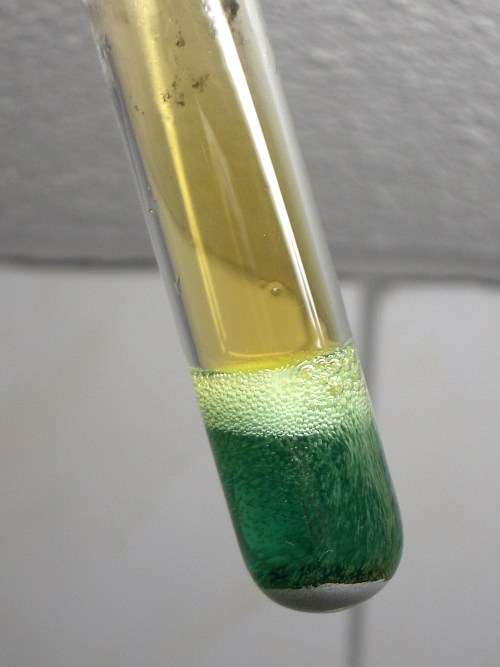
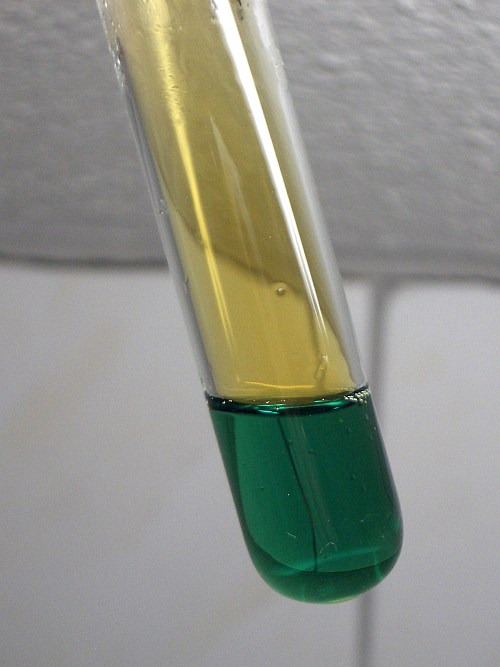
![]()
Discussion of results
![]() Copper(II) ions coordinate to thiocyanate ions through the
nitrogen atom, leading to isothiocyanato complexes. In the presence of excess
thiocyanate and at not too high concentration, these complexes contain
structures like
Copper(II) ions coordinate to thiocyanate ions through the
nitrogen atom, leading to isothiocyanato complexes. In the presence of excess
thiocyanate and at not too high concentration, these complexes contain
structures like
Cu(NCS)n2-n
with additional molecules of water attached to the central metal atom as well. The mix of these complexes is green and the species are anionic (n > 2). This description is a strong simplification of reality. The real structure is much more complex, due to internal redox-reactions (see below).
![]() At high
concentration and in the presence of excess copper(II), exactly two thiocyanate
ions are captured per copper atom and a solid insoluble compound Cu(NCS)2.xH2O
is formed.
At high
concentration and in the presence of excess copper(II), exactly two thiocyanate
ions are captured per copper atom and a solid insoluble compound Cu(NCS)2.xH2O
is formed.
![]() All these copper(II) isothiocyanato complexes are rather
unstable, due to internal oxidation/reduction of the compounds. Copper(II) ion
oxidizes thiocyanate, according to the following highly simplified equation:
All these copper(II) isothiocyanato complexes are rather
unstable, due to internal oxidation/reduction of the compounds. Copper(II) ion
oxidizes thiocyanate, according to the following highly simplified equation:
2Cu2+ + 2SCN → 2Cu+ + (SCN)2
This reaction does not occur in its bare form, as presented above, it always leads to formation of copper(I) thiocyanate, so a somewhat better approximation is:
2Cu2+ + 4SCN → 2CuSCN + (SCN)2
But even this is not a precise representation of what happens in reality. In reality, the copper(II) isothiocyanato complexes undergo internal oxidation/reduction, where an electron of an isothiocyanato ligand is transferred to a copper-atom.
![]() (SCN)2 is an unstable compound, which quickly
decomposes in water to some yellow polymeric species of unknown composition.
This might explain the yellow color of the liquid above the precipitate
when the only reactants are copper(II) sulfate and potassium thiocyanate, but
more investigation of this is necessary to make this certain. It might also be
that the yellow color is due to some other complicated copper-species.
(SCN)2 is an unstable compound, which quickly
decomposes in water to some yellow polymeric species of unknown composition.
This might explain the yellow color of the liquid above the precipitate
when the only reactants are copper(II) sulfate and potassium thiocyanate, but
more investigation of this is necessary to make this certain. It might also be
that the yellow color is due to some other complicated copper-species.
![]() The black copper(II) isothiocyanate forms a coarse
precipitate, which settles quickly, while the white copper(I) thiocyanate has a
finer constitution and hence takes longer time to settle.
The black copper(II) isothiocyanate forms a coarse
precipitate, which settles quickly, while the white copper(I) thiocyanate has a
finer constitution and hence takes longer time to settle.
![]() When
sulfite is present, then the reduction of copper(II) to copper(I) is much faster
and complete. The reduction of copper(II) by the sulfite is much faster than
without the presence of thiocyanate. Most likely this
is due to the strong insolubility of copper(I) thiocyanate, so any equilibrium
would be drawn to the side of the copper(I) species, because this is removed
from the system by means of precipitation.
When
sulfite is present, then the reduction of copper(II) to copper(I) is much faster
and complete. The reduction of copper(II) by the sulfite is much faster than
without the presence of thiocyanate. Most likely this
is due to the strong insolubility of copper(I) thiocyanate, so any equilibrium
would be drawn to the side of the copper(I) species, because this is removed
from the system by means of precipitation.
According to the book "Chemistry of the Elements" by Greenwood and Earnshaw, copper(II) forms no thiocyanato complexes, but isothiocyanato complexes, where the N-atom is coordinated to the copper atom, instead of the sulphur atom (see page 326). In copper(I) species most likely there is a polymeric species ...-Cu-SCN-Cu-SCN-...